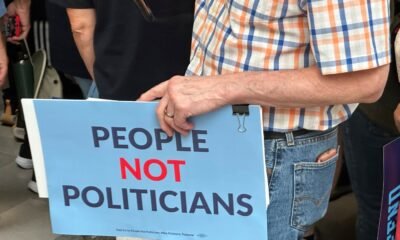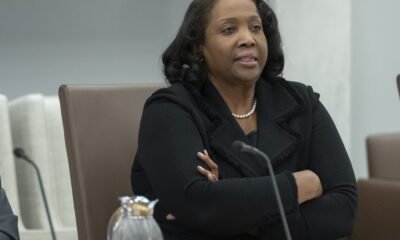Education
Lawsuit saves massive reading experiment

This story was reported by and originally published by APM Reports in connection with its podcast Sold a Story: How Teach Kids to Read Went So Wrong.
The Zoom call was supposed to be a regular check-in for the team at Boston University. They’d wrapped up work on a massive, federally funded study of a system to detect when kids are having trouble learning to read and get them help immediately. The team was just waiting for the data on the early warning system to be analyzed.
But one of the professors, Nancy Nelson, interrupted the call. She had just gotten an email: The Trump administration was canceling the study — the largest experiment on reading ever funded by the Institute of Education Sciences, the U.S. Department of Education’s research arm.
The study had been 6 1/2 years in the making, and results were scheduled to be released in a matter of months. Ninety-three percent of the funds had already been spent. But the Trump Administration was saying the $41 million project was over. Three years of data, collected from more than 100 elementary schools in seven states, was being shelved.
Carol Dissen, a teacher trainer on the Boston University team, was stunned. She never expected it, “never in a million years.” She thought about all the students she believes would have benefited from the early warning system, and the tears flowed.
Disadvantaged kids “rely on our school system in order to change the trajectory of their lives,” Dissen said, still choking up as she recalled the February meeting months later. “We worked hard for three years to show that it works and that you can make a change for those students. And to hear that the data wasn’t going to be analyzed and shared, it’s devastating — absolutely devastating.”
If it hadn’t been for legal action, the results of the study on the early warning system might never have been released. But in response to a lawsuit filed by two research associations, lawyers for the Trump administration said in June that it would voluntarily reinstate the contract for the study — a concession it argued should allow the administration to go forward with its other deep cuts to education research.
That study was just one of about 106 education-related contracts totaling $820 million that the Department of Government Efficiency terminated. The abrupt cancellation meant researchers missed their year-end data collection, punctuating large-scale experiments and longitudinal studies with question marks. They cut students off from services, taking mentors away from high school students with disabilities trying to plan for life after graduation.
A spokesperson for the Department of Education did not respond to an email requesting comment.
Tabbye Chavous, executive director of the American Educational Research Association, one of the groups that filed suit, said that the administration did “begin to backtrack” by restoring some contracts. But she said that most of the institute’s research and data functions have not been restarted, in spite of Congressional mandates, and the layoffs have left it without the staff necessary to complete that work.
When contractors resume the early warning system study, they will be reporting to a much-diminished agency. Layoffs have shrunk the Institute of Education Sciences to a tenth of its former size. The specialist who oversaw the contract is gone. And researchers worry about how the cancellations will affect future studies — and schools’ willingness to use that research in their decision-making.
It’s an episode that highlights the new administration’s approach to governing — flipping projects off and on, seemingly with little regard for the consequences, all in the name of efficiency.
“What’s efficient about that?” asked Kim Gibbons, a researcher at the University of Minnesota who was also involved in the study. “It doesn’t make any sense to me. But probably, like all of us, I’m learning a lot of things don’t make sense right now.”
Related: Become a lifelong learner. Subscribe to our free weekly newsletter featuring the most important stories in education.
The early warning system at the center of the reinstated study is formally known as a multi-tiered system of support for reading. The idea is to identify struggling readers early and get them targeted help before they fail.
The system is modeled after medicine — the same way doctors monitor symptoms and escalate treatments for a worsening illness. A person with a fever might take a day off work to rest. If it doesn’t go away, they’ll get a check-up from a doctor and maybe some medication. But if the bug lasts, they might need a stronger prescription.
The early warning system takes a similar approach, dosing up the intensity of instruction based on student needs. The system starts with a strong reading curriculum for all students, adds small-group lessons for those falling behind and provides one-on-one interventions for the most at-risk students. Testing continues throughout to measure how students respond.
Before, “you had to wait to fail in order to be eligible for special education,” said Nelson, the Boston University professor. “You had to be far enough behind your peers that you were found eligible.” The idea behind the early warning system, Nelson explained, “was to try and provide some support to students between general and special education. It really created that supplemental space that was missing before.”
A 2015 federal law recommended schools adopt this rapid response system. In the years after, many schools said they’d added it, but researchers agree that few implemented it well.
So in 2018, the Institute of Education Sciences hired contractors from the American Institutes for Research, a nonprofit organization that conducts social science research, to run the experiment.
Mike Garet, a vice president at the American Institutes for Research, said each component of the early warning system has lots of research to back it up, but the model hadn’t really been tested in an experiment. They had to see if the benefits of the system would be worth the teachers’ time.
“You could imagine a school that could spend a lot of time trying to schedule students’ assessments, scoring them, having meetings about them, scheduling (small-group) instruction and keeping track of the materials. And they spend so much time doing all that, actually they don’t have enough time left to teach reading,” Garet said.
“There’s a lot of theoretical arguments for why it should work,” he added. But until this study, “we didn’t really look carefully at all the engineering details that are required to do that well and to get good results.”
The federal government’s large-scale evaluations don’t just confirm whether a program works in theory: They’re meant to reveal what it takes to make it work in hundreds of classrooms with different students.
Over 6 1/2 years, right through the pandemic’s closures, the contractors from Garet’s organization identified two promising models of this early warning system, recruited seven school districts to join in a randomized experiment and collected three years of data. They methodically compared how the two models fared against the way schools usually operated — amid the messy reality of a large-scale rollout.
Annette Sisler, an elementary school principal in Junction City, Oregon, adopted one of the models, Enhanced Core Reading Instruction, this school year. Before her school adopted the model, Dissen, the education consultant from Boston University, had asked Sisler to follow a small group of children throughout the day, observing what lessons they received.
Sisler remembered one first grade girl who did well in a phonics lesson with all her classmates, smiling and engaged. But later in the day, with a different phonics lesson in a small group, she looked confused. Then, in yet another phonics lesson for her special-education class, she became so frustrated that she kicked another student. The instruction was disjointed, Sisler found.
“It was all out of line,” Sisler said. The student “doesn’t know what lesson she’s on, what she’s supposed to be learning, how to apply it. We weren’t priming her little brain to then be ready to read.”
Sisler said the new model brought lessons into alignment. After just one year, the share of her second grade students struggling with reading fluency dropped from 43 percent in the fall to just 8 percent in the spring.
School districts want to do what’s right for their students, Nelson, the Boston University professor, said. But they need studies to know what’s actually right for their students. “In the absence of those data, they’re doing it a little bit more blindly.”
Related: Suddenly sacked
The reinstatement of the early warning system study remains an exception. Of more than 100 canceled contracts from the Institute of Education Sciences, the Trump administration has reinstated only 12 of them, according to a June court filing and a review of federal spending data. Lawyers said the administration is reevaluating whether to reinstate or rebid up to 16 others.
By reinstating this one contract, the administration’s lawyers argued the department had fulfilled its congressionally mandated duty to evaluate how effectively students with disabilities are being taught. They argued they shouldn’t have to bring back two other large-scale special education studies. A longitudinal study that had been going on for 14 years and a $45 million experiment to help students with disabilities succeed after high school both remain dead, according to the administration’s lawyers.
Researchers say the cancellations are already affecting other federally funded studies, as school districts are now hesitant to sign up for experiments that could be nixed midway through. It already takes a lot of convincing to sign districts up for a randomized experiment. Only some of their schools will get the promising program that’s being studied, and evaluators will be a constant presence, monitoring compliance and collecting data. Nelson said the disruption of the early warning system study left some school superintendents “skittish” about participating in one of her follow-up studies.
Education researchers know that protecting their relationships with schools is one of their most important jobs, Nelson said. The Trump administration’s actions were “a major, terrible example of how to completely disrupt those relationships,” she said. She said the cancellation had only increased “mistrust” in research among educators.
While a few studies are running again, the Institution of Education Sciences now has limited capacity to undertake future large-scale experiments — and then translate the findings into practice.
“It’s a critical activity, finding out what works for whom under what circumstances,” said Russ Whitehurst, the institute’s founding director under President George W. Bush. “You can’t do it if you don’t have offices that are equipped to collect and disseminate the information.”
The Institute of Education Sciences, for instance, distilled takeaways from research in handy practice guides for teachers. Those contracts were canceled and aren’t coming back.
Garet, the American Institutes for Research vice president, said the early warning system study shows just how hard it is to get school systems to change. It takes far more than publishing a paper, even one that reports significant positive effects.
“Unfortunately,” he said, “scientific results aren’t self-implementing.”
Education
AI tools to sweep through UCLA STEM departments, expanding education through AIMS

AI learning tools will be introduced to undergraduate physics and math courses this fall.
The Artificial Intelligence and Math Skills program, a two-year project aiming to decrease learning disparities in introductory STEM courses, will be implemented across physical and life science courses to improve student learning experiences, according to the UCLA Center for Education Innovation & Learning in the Sciences website. The program will use supplemental math materials and AI hinting tools to support students who need more support with mathematical skills, according to the website.
The initiative stems from a joint study conducted by UCLA and UCSD faculty members, which found that incentivized supplemental math assignments are associated with improved exam performance.
Alexander Kusenko, a professor of physics and astronomy at UCLA who serves as the primary investigator for the AIMS project, said levels of performance in calculus and physics courses vary for students from different socioeconomic backgrounds. The results of the study showed that supplemental learning methods and Kudu – an AI learning platform that provides restricted AI-generated hints to students needing support – were associated with higher exam scores for students, he added.
This learning model can be applied in many undergraduate STEM courses, said Shanna Shaked, senior associate director of CEILS who serves as a collaborator on the AIMS initiative. She added that she believes one of the most exciting aspects of this model is how it incentivizes supplemental math activities, as the students who score lowest on exams will earn the most points for completing the supplemental resources.
“That makes me very excited, because we have discovered something useful. And it’s working for all the students, but particularly for the students who need most help,” Kusenko said.
Shaked said the AIMS initiative is funded by the Teaching and Learning Center Tier 4 Grant – which supports larger-scale educational innovations that promote student exploration, creativity, engagement, discovery and success, according to the TLC website. The program was awarded a Track 2 Implementation Grant, which can provide up to $100,000 to teams of faculty and students seeking to tackle student needs and challenges through pedagogical transformation, the website said.
K. Supriya, associate director of CEILS who co-authored the study and serves on the AIMS program, said federal funding cuts affected research for this initiative, as researchers submitted an NSF proposal a few days before UCLA’s funding was paused, and have yet to receive feedback.
[Related: Research grant suspension impacts applied mathematics program, collaboration]
Shaked added that the TLC grant was critical to the implementation of the AIMS project because it is not associated with national funding allocations, allowing research to continue.
“Thanks to that grant, we’re able to keep doing some of the work,” Shaked said. “Not nearly in as much depth or with as much evaluation and research as we would like, but certainly able to continue broadening the use of these promising interventions.”
The TLC funds will be used to support graduate students who help develop materials for the program, as well as the instructors and investigators who implement the program, Shaked said. She added that the grant allows researchers to continue working on the AIMS project, but many participating faculty members are also being impacted by the research funding freeze, which makes adequate compensation for their work and time more challenging.
As the program grows, Supriya said the project will expand its implementation of AI learning tools to introductory chemistry courses, such as general chemistry, with the hope of reaching life sciences courses.
If evidence shows that incentivized supplemental assignments are effective in different contexts and settings, these tools could be useful for instructors at all levels and for all kinds of courses, Supriya added.
As AI becomes increasingly integrated into higher educational institutions, Supriya said researchers should explore how initiatives like AIMS can maintain or increase student learning by offering tailored support.
“It’s a helpful tool,” Supriya said. “I only see the use of such things growing over the next five years.”
Contributing reports by Shaun Thomas, science and health editor.
Education
What I wish I knew before going to university

 BBC
BBCOver the next couple of weeks, hundreds of thousands of new students will descend on universities around the country.
For many, this will mark the start of a brand new adventure – though one often filled with a lot of worry.
To help with nerves, BBC News asked for tips from 2024’s first-years, who’ve already sussed out being freshers.
From balancing studies and social life, to looking after your mental health and the importance of doing the washing up, this is what the class of 2024 have to say to the new kids on the block.
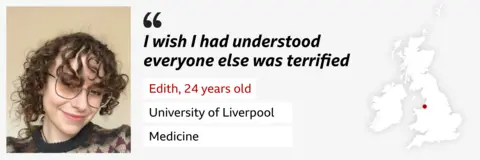
Edith Adam says she was “terrified” when she moved to Liverpool last year to study medicine.
What she hadn’t realised at the time was that other freshers were just as scared as she was.
“I was absolutely terrified about not being able to make friends or that people wouldn’t like me,” says Edith, who’s now going into her second year.
“I wish I had understood everyone else was terrified, and that they appreciate it when you go up to them and say hi.”
 Edith Adam
Edith AdamHaving never been to Liverpool before – a city with a party reputation – Edith worried she might not fit in.
“I was really scared of being ostracised for not wanting to go clubbing every night and not being a drinker,” she says.
But Edith was still able to find her people.
“No one actually cares. There are plenty of things you can do that don’t revolve around late nights. Just find what works for you.”
 Edith Adam
Edith AdamThe 24-year-old, from Huddersfield, says her advice would be not to put too much importance on the infamous freshers’ week.
“I think everyone goes in with the expectation that it’s this amazing, wild week, where you meet your best friends for life and have your best time at uni,” she says.
And her top tip for staying friends with your flatmates?
“If it takes less than two minutes, just do it,” Edith says. “It’s so easy for everything to pile up, and then you don’t wash your plates for five days, and all of a sudden everything is dirty and you have no cutlery – and your flatmates hate you.”
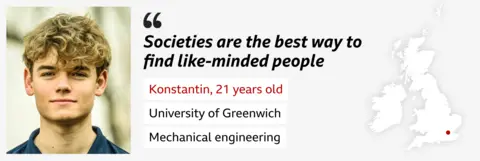
But what if you can’t make freshers week?
This is the situation Konstantin Schmidt faced last year, after issues with his visa delayed his start at Greenwich University by five weeks.
Although people told him the freshers parties he’d missed out on were “fun”, the mechanical engineering student says he still managed to settle in well by joining up to student clubs.
“Societies are the best way to find people who share the same passion,” Konstantin says.
 Konstantin Schmidt
Konstantin SchmidtJoining both a volleyball society and the Formula One society, he says he had positive interactions right from the off.
“The second I joined the room the members saw I was new and instantly included me,” Konstantin says. “I also met new people through volleyball who were on my course who quickly became my friends.”
 Konstantin Schmidt
Konstantin SchmidtThe 21-year-old bonded with his flatmates by exploring each other’s culture through food and music.
In his first weeks, Konstantin, who’s from Bavaria in Germany, made Spätzle – a pasta dish topped with grilled cheese for a dinner party with his flatmates.
“Everyone really liked” his food, he says – but he admits the best dish was a Filipino one made by his flatmate, Kai.
“It helped us understand everyone’s culture even better,” Konstantin says.
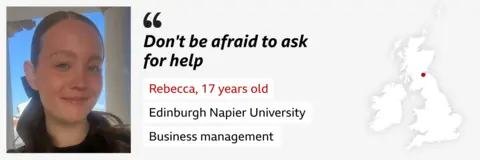
While many people starting university will be living away for the first time, some students still live at home.
Commuting more than an hour each way between Glasgow and Edinburgh, Rebecca can relate.
“If they forget something, my friends can just nip back to their accommodation, whereas I can’t, ” she says. “But it’s not bad, I like commuting in.”
Going into her second year of a business management course, Rebecca is now much more organised and comfortable with the journey, after experiencing some hiccups in her first year.
 Handout
HandoutIn some cases, cancelled trains meant she had to pay for a taxi all the way to Edinburgh.
“In second year I will definitely be checking my trains,” Rebecca says.
Her advice for freshers is simple: “Make sure your bag is fully packed with everything you might need – and plan your commute.”
Rebecca’s university experience has been different from many others as she was only 16 when she started her course.
“I thought everyone was going to be older and not want to speak to me,” she says. “But it wasn’t like that at all. The age gap doesn’t really matter.”
 Handout
HandoutNow 17, Rebecca is still waiting to experience a full freshers’ week, but says she was still able to attend under-18 events.
Her advice for those in a similar position?
“Don’t be afraid to ask for help,” she says. “I felt like I couldn’t ask for help because people would think I didn’t deserve to be there because I’m younger.
“They don’t care that you’re 16 or 17. Just ask for help.”
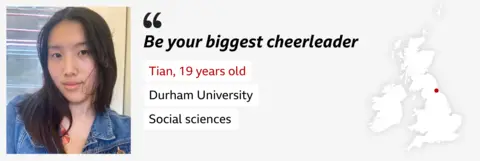
As the first in her family to go to university, Tian Liu didn’t know what to expect before she started her combined honours degree in social sciences.
“I did so much research, but I still felt so unprepared,” Tian says. “University is definitely a roller coaster. There was a point I wanted to drop out, but now I can definitely see the fruits of my labour.”
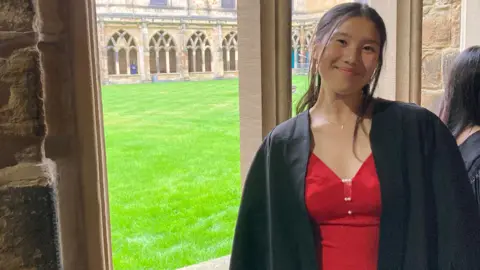 Tian Liu
Tian LiuNow going into her second year, the 19-year-old has found a better balance and would advise incoming students to look after their mental health.
“With tuition fees rising there is such a pressure to make the most out of it, but you can burn out,” Tian says. “University is as much as you make of it, but give yourself grace.
“Have close friends who can act as support and accountability if you are doing too much, and use pastoral teams that the university offers,” she adds.
“There is no need to rush, it’s all a constant learning curve.”
 Tian Liu
Tian LiuOne year on from moving to Durham from Leeds, Tian is in New York completing an internship she got through her university – something she “could never have imagined” last year.
Her advice for incoming students?
“Don’t disqualify yourself from anything. Be your biggest cheerleader. And take so many photos.”
Education
Franklin County Schools considering AI gun detection software
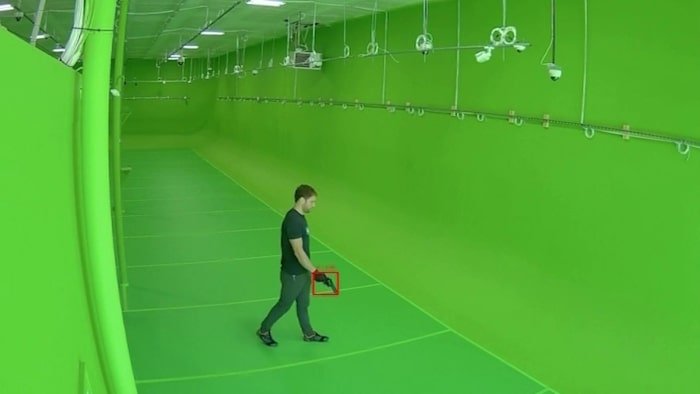
FRANKLIN COUNTY, Va. – School board members are discussing the use of artificial intelligence to detect guns on school grounds.
Superintendent Dr. Kevin Siers said the board has been exploring options, including software from Zero Eyes that uses existing security cameras and AI to identify firearms and alert an incident center within seconds.
“We take safety and security very serious,” Siers said. “So that caused us to take a deeper look into what options are available for weapons detection.”
Dustin Brooks, a co-founder of Zero Eyes, said the system is designed to be proactive and to prompt an immediate response. He described a process in which a camera detects a gun, an operations center verifies the alert, and then dispatches notifications to the school and local authorities.
“From detection — gun brandished in front of camera, camera picks up gun, operation center verifies alert, dispatch alert, customer receives alert — that process can be, you know, as fast as three to five seconds,” Brooks said.
Brooks said human analysts review any images the AI flags, which he said reduces false alarms. He added that the system is narrowly focused on detecting firearms and does not share other images with the information center.
“We’re looking for guns. The only thing that we’re looking for is guns,” he said.
Siers emphasized the move is to prepare for dangerous incidents before they even happen.
“Our resource officers do a great job of trying to study those incidents when they occur and then trying to apply how the lessons learned there might be applied in our schools,” he said. “So it’s just an ongoing process and, unfortunately, it’s something that too many schools are having to deal with.”
If approved, the technology would be implemented at Franklin County Middle School and Franklin County High School.
Roanoke City and Salem Public Schools are among other districts that have used or are considering similar AI detection software.
Copyright 2025 by WSLS 10 – All rights reserved.
-

 Business2 weeks ago
Business2 weeks agoThe Guardian view on Trump and the Fed: independence is no substitute for accountability | Editorial
-
Tools & Platforms1 month ago
Building Trust in Military AI Starts with Opening the Black Box – War on the Rocks
-

 Ethics & Policy2 months ago
Ethics & Policy2 months agoSDAIA Supports Saudi Arabia’s Leadership in Shaping Global AI Ethics, Policy, and Research – وكالة الأنباء السعودية
-

 Events & Conferences4 months ago
Events & Conferences4 months agoJourney to 1000 models: Scaling Instagram’s recommendation system
-

 Jobs & Careers2 months ago
Jobs & Careers2 months agoMumbai-based Perplexity Alternative Has 60k+ Users Without Funding
-

 Podcasts & Talks2 months ago
Podcasts & Talks2 months agoHappy 4th of July! 🎆 Made with Veo 3 in Gemini
-

 Education2 months ago
Education2 months agoMacron says UK and France have duty to tackle illegal migration ‘with humanity, solidarity and firmness’ – UK politics live | Politics
-

 Education2 months ago
Education2 months agoVEX Robotics launches AI-powered classroom robotics system
-

 Funding & Business2 months ago
Funding & Business2 months agoKayak and Expedia race to build AI travel agents that turn social posts into itineraries
-

 Podcasts & Talks2 months ago
Podcasts & Talks2 months agoOpenAI 🤝 @teamganassi


